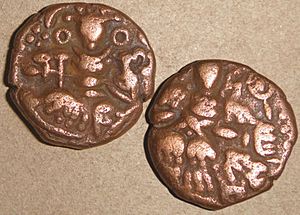Didda facts for kids
Quick facts for kids Didda |
|
|---|---|
| The Lame Queen of Kashmir | |

A coin featuring Queen Didda.
|
|
| Queen of Kashmir | |
| Reign | 980 – 1003 |
| Predecessor | Bhimagupta (r. 975 – 980) |
| Successor | Samgrāmarāja (r. 1003–1028) |
| Queen Regent of Kashmir | |
| Regency | 958 – 980 |
| Monarch |
|
| Born | c. 924 |
| Died | 1003 (aged 79) |
| Spouse | Kshemagupta |
| Issue | Abhimanyu II |
| House |
|
| Father | Simharaja, King of Lohara |
| Religion | Hinduism |
| Relatives | Bhimadeva Shahi (maternal grandfather) Udayaraja (brother) Samgrāmarāja (nephew) |
Didda (born around 924 CE, died 1003 CE) was a powerful ruler of Kashmir. She is sometimes called The Catherine of Kashmir because she ruled for a long time. Didda was first a regent for her young son and grandsons from 958 CE to 980 CE. After that, she became the sole ruler of Kashmir from 980 CE until her death in 1003 CE. Most of what we know about her comes from a book called Rajatarangini, written by Kalhana in the 1100s.
Queen Didda's Early Life
Didda was the daughter of Simharāja, who was the King of Lohara. Her mother's father was Bhimadeva Shahi, a ruler from Kabul. The Kingdom of Lohara was in the Pir Panjal mountains. This area was important because it was on a trade route between western Punjab and Kashmir.
When Didda was about 26 years old, she married Kshemagupta, the King of Kashmir. This marriage helped to connect the Kingdom of Lohara with Kashmir. Even before she officially became a regent, Didda had a lot of influence in how the kingdom was run. Some old coins even show both her name and Kshemagupta's name.
Becoming a Regent
In 958 CE, King Kshemagupta passed away after getting sick during a hunt. His son, Abhimanyu II, became king. However, Abhimanyu was still a child. So, Didda stepped in to rule as a regent. A regent is someone who governs a kingdom when the rightful ruler is too young or unable to rule. In Kashmir during this time, women were generally respected and held important positions.
Didda's first challenge was dealing with powerful ministers and nobles who caused trouble. She removed them from their positions, but they rebelled against her. It was a difficult time, and she almost lost control. But Didda was very determined. She got support from others, even by offering gifts, and managed to keep her power. She was very firm with those who rebelled.
More problems arose in 972 CE when Abhimanyu II passed away. His son, Nandigupta, who was also a young child, became king. This led to unrest among the Dāmaras. These were powerful landlords who would later cause many issues for the Lohara dynasty that Didda helped to establish.
Nandigupta's rule ended in 973 CE. Then, his younger brother, Tribhuvanagupta, became king, but his reign also ended in 975 CE. After this, Didda's youngest grandson, Bhimagupta, took the throne. Didda continued to be the regent for him. She became even more focused on having complete power. She also relied on a trusted advisor named Tunga. In 980 CE, Bhimagupta's rule ended, and Didda took full control of the kingdom herself. Tunga became her prime minister.

Didda as Queen
Didda ruled as the Queen regnant of Kashmir from 980 CE until she passed away in 1003 CE. She was about 79 years old. She is one of the very few female monarchs in Indian history. People sometimes compare her to Catherine the Great of Russia. This is because both queens ruled for a long time and were very strong leaders.
Even though there were still some problems with the Dāmaras, Didda and Tunga were able to handle them. They used both military strength and smart negotiations. Historians have noted that Didda was a very skilled leader. She managed to keep the throne of Kashmir peaceful and passed it on to her own family without any arguments.
Didda adopted her nephew, Samgrāmarāja, as her heir for Kashmir. He was the oldest son of her brother, Udayaraja. This decision led to the start of the Lohara dynasty in Kashmir.
It's important to know that Mahmud of Ghazni, a powerful invader, did not attack Kashmir during Didda's rule. She died in 1003 CE, and Mahmud of Ghazni's invasions of Northern India began later, during the rule of Didda's successor, Samgrāmarāja. In 1015, Mahmud of Ghazni's attempt to invade Kashmir failed. This was because he couldn't capture the fort of Loharkot, and the weather and mountains made it too difficult.

